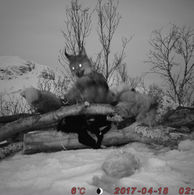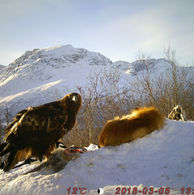My First Camera Trap

An early morning in March 2016 I was driving to work when I suddenly saw two animals crossing the road around 300 meters in front of my car. The light was poor and I didn't realized what kind of animals I just have seen. The moment I got closer to the crossing point I slowed down my car to see if I can spot these animals. There they stood, just five meters from the road. two wild lynxes were looking at me before they turned around and disappeared in the forrest. From that moment I had a dream of getting this elusive cat in front of my camera.
In the beginning of 2017 I found some fresh tracks of the lynx not so far from our place and I scouted the area for more signs of the lynx. At this time, I had no experience with camera traps and didn’t even know that there were motion sensors for DSLR available. I decided to set up one of my trail cams and found a spot I thought might be a good place to start my little photo project. I got a dead red fox from a friend which I used as bait to increase the chance of getting some images of the lynx. After 2 weeks I surprisingly got lucky and a lynx appeared in front of my trail cam, but during the last days we got a lot of snow and the lens of my trail cam was covered with snow. This snowy weather continued during the next 2 weeks and even if the lynx several times was in front of my trail cam I didn't got any image.

At the end of March 2017 I finally got lucky. The weather improved and I got my first images of a wild Eurasian lynx. The Lynx showed up 5 days in a row from the 17th to the 21st of March 2017 and some visits lasted even for several hours. And it even got better. In the beginning of May another lynx appeared in front of my trail cam. This lynx had big black spots across the body. It didn't stayed long and the trail cam did just take 3 images. That was the last image before the summer season. A good start for my little photo project.

The next step was to prepare for the next winter season. My father-in-law is a very handy man and he ordered some parts and build me a motion sensor. This sensor is very simple, but connected to my DSLR it turned it to a trail cam, just with better image quality. The self made sensor wasn't weather sealed so I had to find a way to protect it from the harsh arctic winter.
In November 2018 we had our first snow and in the beginning I just installed my trail cam again. This time it took many months before anything happened. In the beginning of March 2018 I got visit of an unexpected guest.
The golden eagle.
After my trail cam took images and videos from the golden eagle I wanted to test my new self build motion sensor. I didn't want to place the camera to close so I used a 100-400mm lens and Placed my camera a few meters away covered under snow. the motion sensor had fortunately a longer cable so it was possible to put it closer to the bait. that's when I for the very first time got images with my own camera trap.
It wasn't a lynx, but an impressive golden eagle.

Canon 5D mark III + Canon 100-400mm f/4.5-5.6L IS II USM
Settings: f/5.6 - 200mm - 1/800 sec - ISO640

Canon 5D mark III + Canon 100-400mm f/4.5-5.6L IS II USM
Settings: f/5.6 - 200mm - 1/800 sec - ISO640
MY First Image of a lynx!
But the day with the golden eagles was just getting better. when I checked my memory card I discovered that The last image was of an Eurasian lynx.
I couldn't believe it.
After the golden eagles left the lynx appeared just at sunset. The lynx didn't stayed for long and I just got this one image.
If you look closer at the image you even can see a juvenile white-tailed eagle sitting on top of a tree in the background.
During March 2018 The lynx visited the location several times at night and during the day.


After the lynx showed up I installed my camera trap with an 16-35mm lens and used a new motion sensor from Camtraptions. Now I was hoping for a new visit of this fantastic wild cat. And I didn't need to wait long. The lynx was back a few days later at day time, but the first visit was very short and the lynx was partly behind the bait. Not a good image, but still I was satisfied to be able to get an image of the lynx. My camera took just 3 images before the lynx left. I was a bit concerned that the sound of the camera scared the lynx away, due to the short visit.

Canon 5D mark III + Canon 16-35mm f/2.8L II USM
Settings: f/9 - 29mm - 1/1250 sec - ISO640

But I didn't needed to be concerned. The next day the lynx was back at the evening and stayed this time for several hours.
I finally got a fair image of the Eurasian lynx with beautiful light in the background. That was also the last visit before the summer season.
Canon 5D mark III + Canon 16-35mm f/2.8L II USM
Settings: f/9 - 29mm - 1/1250 sec - ISO640
Around November 2018 I placed my trail cam again to see if the lynx will be back for another season, but I needed to wait until the end of January 2019 before the lynx showed up.
2019 should become my most successfully season ever, but also a sad one.
For the first time my trail cam got the images of a family group, a female with her kitten.
Now it was time again to place my camera trap and this time I decided to install two cameras.
One camera with settings for day photography and the other one for night photography.
The lynx is mainly active during night or late evening and early morning, but according to the images from my trail cam the lynx has also been active during day.
I also used for the first time a flash which I need if I want to take images of the lynx during the night.

And the female lynx showed up again at the end of February 2019 at day time and this time with her kitten. It seems she had one kitten which always was close by.


And then I got really lucky.
In March 2019 at a night with a full moon and a dancing northern light the lynx visited my camera trap.
Even if this image isn't perfect, I had a dream of this kind of image.

Canon 5D mark II + Samyang 14mm f/2.8
Settings: f/2.8 - 14mm - 1,5 sec - ISO3200

28th of March 2019 the lynx visited my location for the last time before the summer season. This time the lynx stayed several hours at day time and my camera took around 2000 images of the female lynx and her kitten.
In October 2019 I putted my camera trap up again and didn't need to wait long.
In November the female lynx was back and this time with two kittens.
Over a period of 3 days she showed up with here kittens in front of my camera trap.
I couldn't believe it that I was so lucky.

I was so happy and had high hopes for the winter season 2019/2020. Unfortunately both kittens got hit by a car while crossing the road in two different incidents. The female didn't visited my spot for the next months, but I knew she was not far. Several times when I was walking through the forrest or a bit higher up the mountains I found tracks of her.
11th of January 2020
“The day I got fooled by a lynx.”
It was snowing during the whole night and the landscape was covered in snow. I packed my camera bag in the morning and went into the forrest to see if I can take some nice photos of the white landscape. Not far from the cabin I found fresh lynx tracks and started to follow them. “I knew they were fresh and wanted to see where the lynx went.”
After a while I stopped following the tracks due to steep terrain. When I got back to the cabin I discovered that the lynx hasn't been so far while I was following the tracks. The lynx walked in circles around me and passing by the cabin, while I was following the tracks.


To the left you can see the last image of the female lynx.
At this time I didn't now, but she just disappeared and I never have seen her since again.
I don't now why. She lost both of her kittens and
That might be the reason. but I'm afraid that she is not among us anymore. The average age of a wild lynx is around 5 years and I believe she might have been even older then 5 years.
Even if the lynx is a threatened species in Norway, they issue a quota on the lynx and opening the hunt in February and March every year. So I'm afraid that she was killed during one of these licensed hunts or even got killed during an illegal hunt. I still hope that she still is around and just moved to another area after she lost her two kittens.
Now it's over 20 months since I got my last image of the Female lynx. I still place my camera trap, but with not much success. In November 2021 we had up to several 100 reindeers in our area and on the 11th of November my camera trap managed to get this photo of a reindeer under the northern light. Imagine to get tis kind of image with a lynx.

But it's also important never to give up And I got very surprised when I checked my camera trap in December 2021. On the 5th and 30th of December 2021 I got lucky again. A different lynx appeared in front of my camera trap. You clearly can see that this is a different lynx. He had a lot of black spots around his body and I believe that this one is a male lynx due to the seize of the paws. It might be even the same lynx my trail cam took images of back in 2017. this lynx wasn't very comfortable with the sound and the flash of my camera trap and both visits were just about a minute before he left.










































